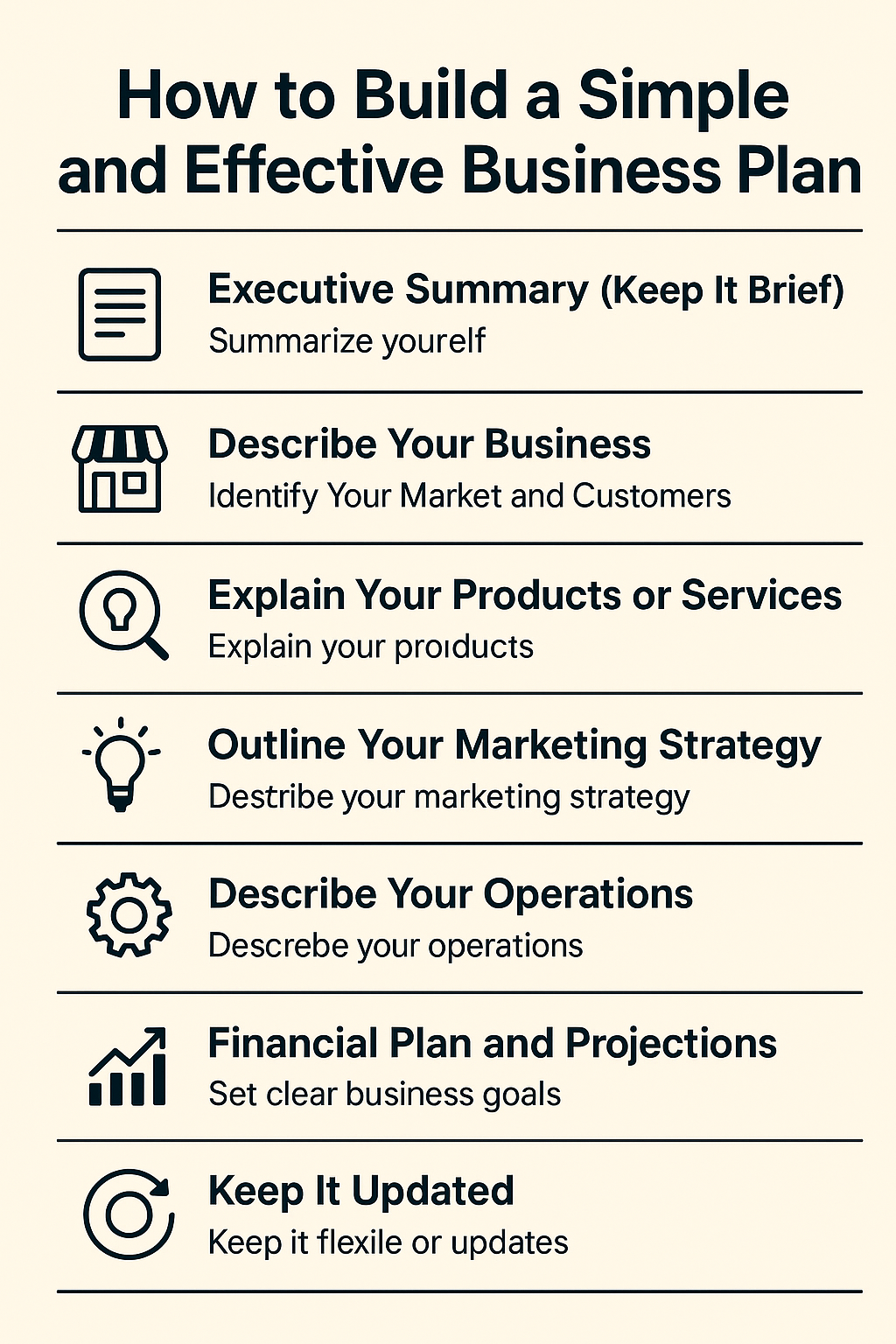Many new entrepreneurs think a business plan is something only large companies need — or that it has to be a 50-page document filled with complex charts and market data. The truth is, a simple business plan can be one of your most powerful tools when starting a small business.
In this article, you’ll learn how to build a straightforward, effective business plan that gives you clarity, keeps you focused, and increases your chances of success — even if you’re just starting out with no experience.
What Is a Business Plan?
A business plan is a written document that outlines your business idea, goals, and the steps you’ll take to reach them. It’s both a guide for yourself and a way to show others (like investors or partners) that you’ve thought things through.
Think of it as a roadmap. Without it, you might get lost, spend too much, or miss opportunities.
Benefits of Having a Business Plan
Even a basic business plan helps you:
- Clarify your vision
- Stay focused and organized
- Identify challenges before they happen
- Secure funding or partnerships
- Track your progress over time
You don’t need to overthink it — just get your key ideas down in writing.
Step 1: Executive Summary (Keep It Brief)
This is the first section, but it’s usually written last. It summarizes your entire business plan in a few paragraphs.
Include:
- What your business does
- Who it serves
- What problem it solves
- Your goals for the next 6–12 months
Keep it short and direct — think of it like your “elevator pitch” in written form.
Step 2: Describe Your Business
Here, explain:
- Your business name and location
- Legal structure (sole proprietor, LLC, etc.)
- Industry and type of business (online store, consulting, local service, etc.)
- What makes your business unique
Be clear and confident, even if your business is just getting started.
Step 3: Identify Your Market and Customers
Understanding your audience is essential. This part of your plan shows that you know who you’re selling to and why they’ll care.
Answer questions like:
- Who are your ideal customers?
- What are their main problems or needs?
- Where do they spend their time online or offline?
- How will you reach them?
You can create a simple customer persona to visualize your audience.
Step 4: Explain Your Products or Services
Describe what you’re offering in detail.
Include:
- Features and benefits of your product/service
- What makes it different from competitors
- How it solves the customer’s problem
- Future ideas or product expansions (if any)
Be sure to explain why people will choose you over others.
Step 5: Outline Your Marketing Strategy
Now that you’ve defined your product and audience, explain how you’ll promote your business.
Possible strategies:
- Social media marketing (Instagram, TikTok, Facebook)
- Email newsletters
- Google Ads or Facebook Ads
- SEO for your website/blog
- Local partnerships and word-of-mouth
Focus on what fits your audience and budget. You don’t need to do everything — just be consistent with what you choose.
Step 6: Describe Your Operations
Here, explain how your business will function on a daily basis.
Include:
- Who is involved (just you or a team?)
- Tools and software you’ll use
- Inventory or supply needs
- Shipping or delivery processes
- Customer support
This section helps you see the real-world workflow of your business.
Step 7: Financial Plan and Projections
You don’t need to be an accountant to make a simple financial plan. Start with rough estimates and refine them over time.
Include:
- Startup costs
- Monthly expenses (rent, software, marketing)
- Revenue goals
- Pricing strategy
- Expected profit over 6–12 months
Even basic numbers can help you stay in control and avoid running out of money.
Step 8: Set Clear Business Goals
A strong business plan includes clear, measurable goals. These can guide your actions and help you stay motivated.
Examples:
- Get your first 20 paying clients in 3 months
- Reach $1,000/month in revenue in 6 months
- Grow Instagram following to 5,000 in 4 months
Make your goals SMART: Specific, Measurable, Achievable, Relevant, Time-bound.
Step 9: Keep It Updated
Your business will evolve — and so should your plan. Review it every 3–6 months to check:
- Are you hitting your goals?
- Do you need to adjust your strategies?
- Has the market changed?
A business plan is a living document — keep it flexible and relevant.
Final Words: Your Roadmap to Success Starts Here
A business plan is not just paperwork — it’s a powerful way to organize your thoughts, avoid costly mistakes, and stay on track. Don’t wait until everything is perfect. Write your plan as you go. Start simple and improve it over time.
It’s better to have a short, realistic business plan than no plan at all.
With a clear roadmap in hand, you’ll feel more confident and focused as you turn your business idea into reality.
